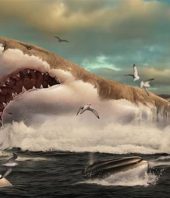Roughly 15,000 years ago, at the end of the last ice age, North America's vast assemblage of large animals -- including such iconic creatures as mammoths, mastodons, camels, horses, ground sloths and giant beavers -- began their precipitous slide to extinction.
And when their populations crashed, emptying a land whose diversity of large animals equaled or surpassed Africa's wildlife-rich Serengeti plains then or now, an entirely novel ecosystem emerged as broadleaved trees once kept in check by huge numbers of big herbivores claimed the landscape. Soon after, the accumulation of woody debris sparked a dramatic increase in the prevalence of wildfire, another key shaper of landscapes.
This new picture of the ecological upheaval of the North American landscape just after the retreat of the ice sheets is detailed in a study published today (Nov. 19) in the journal Science. The study, led by researchers from the University of Wisconsin-Madison, uses fossil pollen, charcoal and dung fungus spores to paint a picture of a post-ice age terrain different from anything in the world today.
The work is important because it is "the clearest evidence to date that the extinction of a broad guild of animals had effects on other parts of these ancient ecosystems," says John W. Williams, a UW-Madison professor of geography and an expert on ancient climates and ecosystems who is the study's senior author. What's more, he says, the detailing of changes on the ice age landscape following the crash of keystone animal populations can provide critical insight into the broader effects of animals disappearing from modern landscapes.
The study was led by Jacquelyn Gill, a graduate student in Williams' lab. Other co-authors are Stephen T. Jackson of the University of Wyoming, Katherine B. Lininger of UW-Madison and Guy S. Robinson of Fordham University.
The new work, says Gill, informs but does not resolve the debate over what caused the extinction of 34 genera or groups of large animals, including icons of the ice age such as elephant like mastodons and ground sloths the size of sport utility vehicles. "Our data are not consistent with a rapid, 'blitzkrieg' overkill of large animals by humans," notes Gill, nor was their decline due to a loss of habitat.
However, the work does seem to rule out a recent hypothesis that a meteor or comet impact some 12.9 thousand years ago was responsible for the extinction of ice age North America's signature large animals.
Source: PHYS.org, Full Article






